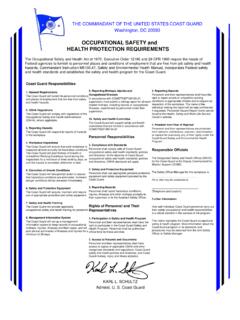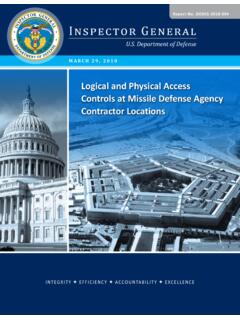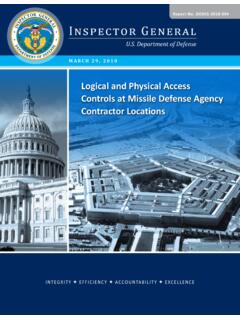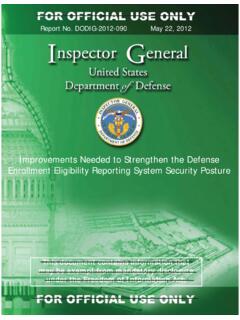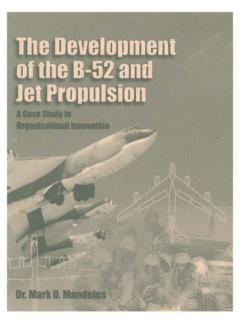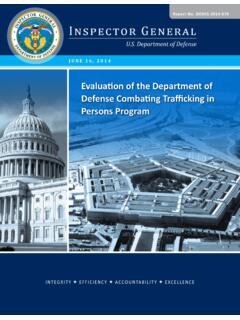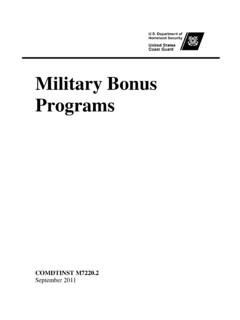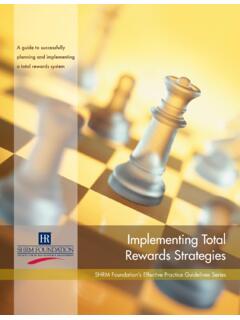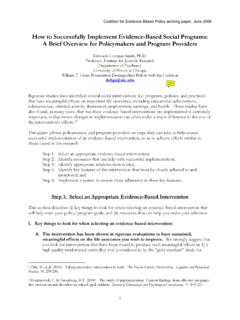Transcription of Implementing the National Defense Strategy: A Year of ...
1 Implementing the National Defense strategy : A Year of Successes THE HONORABLE MARK T. ESPER. Secretary of Defense This July, to mark the one-year anniversary of my tenure as Secretary of Defense as well as two and a half years since the release of the National Defense strategy (NDS) I want to take a look back over the past 12. months and thank the Department of Defense (DoD) and our partners across industry, academia, Congress, and around the world for all that we have accomplished together. During my confirmation hearing last July, I made clear that my top priority would be Implementing the NDS, which informs us that we are now in an era of Great Power Competition; and that China, then Russia, constitute our top strategic competitors. To be successful in this new global environment, we must work along three lines of effort: first, improve the lethality and readiness of the force; second, strengthen allies and build partners; and third, reform the Department for greater efficiency and accountability.
2 I also made a personal priority of taking care of our Service members and their families. Soon after I came into office, civilian and uniformed leaders across the DoD and I met to develop detailed plans to implement these lines of effort. We created a list of ten targeted goals, each with sub-tasks, and we set out to accomplish most of these by the end of 2020. They are as follows: 1. Review, update, and approve all China and Russia plans;. 2. Implement the Immediate Response Force, Contingency Response Force, and Dynamic Force Employment enhanced readiness concepts;. 3. Reallocate, reassign, and redeploy forces in accordance with the NDS;. 4. Achieve a higher level of sustainable readiness;. 5. Develop a coordinated plan to strengthen allies and build partners;. 6. Reform and manage the Fourth Estate and DoD;. 7. Focus the Department on China;. 8. Modernize the force invest in game-changing technologies;. 9. Establish realistic joint war games, exercises, and training plans; and, 10.
3 Develop a modern joint warfighting concept and, ultimately, doctrine. I am proud to report that we have made real progress on these goals, with most on track to be accomplished on time. Today I want to highlight what we have accomplished by working together. Focusing the Department on China First, in light of challenges to the international rules-based order by our strategic competitors in this era of Great Power Competition, one of our top ten goals the priority that drives and underlies many of our efforts today is to focus the Department on China. This is the primary lens through which we are advancing each line of effort under the NDS, which guides us in addressing near-term challenges while preparing us once again for high-intensity conflict in the future. Our Department-wide focus on strategic competition is made possible by senior leadership team meetings held regularly to drive integrated action on China first, then Russia. A newly established China strategy Management Group further pushes that agenda forward.
4 A vital part of that action is the training and education of personnel across the Armed Forces. Our future leaders must understand how China thinks about war, how the People's Liberation Army (PLA) is organized, what kind of weapons and equipment they July 2020. use, and how they fight the way our past leaders and I were once required to understand Soviet systems and doctrine. To hone these skills and reorient the force toward our priority theater, I directed the National Defense University to refocus its curriculum by dedicating 50 percent of the coursework to China, and I tasked the Military Departments and Services to make China the pacing threat in all of our schools, programs, and training. At the same time, our teams are taking a hard look at DoD requirements, acquisition, and other systems to strengthen the foreign military sales process, bring to bear the Defense industrial base, and successfully compete with both China and Russia. Line of Effort 1: Building a More Lethal Force Modernizing the Force Another major goal among our top ten is to modernize the force, to include by investing in game-changing technologies as we transition from a legacy military to a more capable future force.
5 This will allow us to maintain our long-held battlefield overmatch, which is more important than ever, as China and Russia continue to modernize their militaries and pursue advantages in emerging technologies like artificial intelligence (AI) and 5G. Our Fiscal Year (FY) 2021 budget request supports this and related priorities toward irreversible implementation of the NDS. Moreover, we have successfully secured funding for our top 11 modernization initiatives, including hypersonics, artificial intelligence, quantum science, biotechnology, directed energy, microelectronics, and 5G networks, with the largest research and development budget in the Department's history. Additionally, we released modernization roadmaps for these technologies. Hypersonics: accelerating development of hypersonic weapons with plans to start fielding in 2023. We ramped up flight testing, with over 40 flight tests planned in the next five years; a recent test of the Common Hypersonic Glide Body demonstrated readiness by hitting its target after traveling over 2,000 miles in less than 20 minutes, reaching a peak speed of 17 times the speed of sound.
6 Artificial Intelligence: accelerating the fielding of AI capabilities at scale to meet warfighter needs through the Joint Artificial Intelligence Center and created the first-ever AI Ethics Principles to ensure the United States is the global leader in the responsible development and use of AI. Microelectronics/5G: accelerating our access to advanced commercial and specialty microelectronics, and working to leverage the power of 5G for our mission, while preventing adversaries from using it against us. As part of this effort, we initiated large-scale experiments to test and evaluate 5G. communications capabilities at 12 DoD bases, working alongside industry partners. Cyber: Cyber Command (CYBERCOM) continuing to pursue DoD's Defend Forward . strategy that ensures we are persistently engaged with cyber actors to defeat them online, improve the lethality of our Combatant Commands, and support a whole-of-government effort to deliver a safe, secure, and legitimate election.
7 Advanced DoD's digital modernization efforts to enhance IT architecture through cloud; AI;. command, control, and communications; and cybersecurity. The Department is also recapitalizing the strategic nuclear triad and our nuclear command, control, and communications (NC3) system as a top priority; we have made great strides in ensuring the strength and 2. reliability of our Nation's nuclear deterrent. Over the past year, we fielded the new W76-2 submarine- launched, low-yield ballistic missile warhead. We also developed and executed flight tests of experimental versions of two intermediate-range, conventional strike weapons in less than 12 months, following withdrawal from the Intermediate-Range Nuclear Forces Treaty due to Russia's repeated violations of the agreement. At the same time, we are developing next-generation interceptor and ballistic missile Defense systems to keep pace with adversary missile systems and ensure layered Defense of our homeland. Among our modernization efforts, the Department conducted a comprehensive review of the Future Naval Force and shipbuilding plan to meet our needs in the years ahead.
8 In doing so, we are working towards a more lethal, survivable, adaptable, and sustainable fleet of at least 355 ships and likely more that will probably include more and smaller surface combatants, a larger submarine force, and optionally/lightly- manned vessels that will ensure continued dominance on the high seas. Divesting from legacy systems to reinvest in NDS priorities, including: o 177 F-15C aircraft, saving $ billion (Future Years Defense Program (FYDP)) as part of our reform efforts o 17 B-1 aircraft, saving $82 million (FY2021); $ billion (FYDP). o 10 MQ-9 Combat Lines, saving $93 million (FY2021); $445 million (FYDP). o 16 KC-10 aircraft, saving $48 million (FY2021); $551 million (FYDP) upon divesting remainder of the fleet o 24 RQ-4 Block 30/EQ-4 Block 20 aircraft, saving $269 million (FY2021); $ billion (FYDP) as part of our reforms o 13 KC-135 aircraft, saving $40 million (FY2021); $363 million (FYDP). o 13 C-130H aircraft, saving $11 million (FY2021); $307 million (FYDP) upon divesting a total of 45 aircraft o 42 A-10 aircraft, saving $939 million (FY2021); $ billion (FYDP) upon divesting 21.
9 Additional aircraft in FY2022. o B-2 DMS-M system, saving $337 million (FY2021); $482 million (FYDP). Develop a Modern Joint Warfighting Concept and Doctrine Among our top ten goals is the development of a modern Joint Warfighting Concept and, ultimately, doctrine, to enable our transition to All-Domain Operations by aligning our personnel, equipment, organizations, training, and doctrine. The Chairman of the Joint Chiefs of Staff is driving this important effort to prepare us for future warfare. Joint Warfighting Concept (JWC) attributes have been validated, and cross-Service JWC supporting concept teams have been established to move this effort along deliberately, with workshops, wargames, and senior leader tabletop exercises planned over the coming months. As part of this effort, the Air Force is leading the Department's new Joint All-Domain Command and Control (JADC2) initiative, which is vital to linking any sensor to any shooter on the battlefield in real time.
10 We are also Implementing novel concepts such as Distributed Maritime Operations and Expeditionary Advanced Base Operations, which allow us to maintain lethality across land and sea in preparation for future conflict, while the Army is developing and experimenting with Multi-Domain Operations. Additionally, we published a Defense Space strategy and developed new operational techniques for CYBERCOM that increase our capability. 3. Enhancing Lethality and Readiness Several other goals among our top ten are meant to drive the Department's efforts to enhance lethality, as we balance near-term operations and contingencies with readiness. These include the following . Review, Update, and Approve All China and Russia Plans;. Establish Realistic Joint War Games, Exercises, and Training Plans;. Implement the Immediate Response Force (IRF), Contingency Response Force (CRF), and Dynamic Force Employment (DFE) Concepts; and, Achieve a Higher Level of Sustainable Readiness. Many of the achievements listed below fall under one or more of the goals listed above: Updating key war plans for the first time in years through expanded efforts to ensure greater effectiveness, alignment with National policy, and consistency with the NDS.

